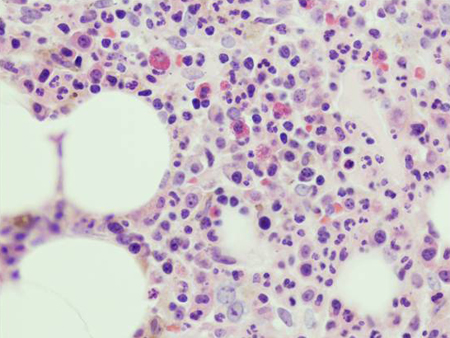Summary
Definition
History and exam
Key diagnostic factors
- at-risk demographic (male, age >50 years, African ancestry)
- clinically asymptomatic
- positive family history
- history of radiation exposure
- history of pesticide exposure
Other diagnostic factors
- history of immunosuppression or infections
- presence of peripheral neuropathy
Risk factors
- male sex
- age >50 years
- African ancestry
- family history of MGUS or multiple myeloma
- immune-mediated conditions
- radiation exposure
- pesticide exposure
Diagnostic tests
1st tests to order
- electrophoresis with immunofixation and measurement of serum immunoglobulins
- CBC with differential
- serum calcium
- serum creatinine
- urinalysis and 24-hour urine collection with electrophoresis and immunofixation
- serum free light chains assay
- metastatic bone survey (conventional x-ray or whole body low-dose CT scan)
Tests to consider
- bone marrow aspiration and/or biopsy
- bone mineral density scan
- MRI scan
- PET scan
Treatment algorithm
confirmed MGUS
Contributors
Authors
Shaji Kumar, MD
Professor of Medicine
Division of Hematology
Mayo Clinic
Rochester
MN
Disclosures
SK has received research funding for clinical trials to the institution from Abbvie, Amgen, Allogene, Astra-Zeneca, BMS, Carsgen, GSK, Janssen, Novartis, Roche-Genentech, Takeda and Regeneron. SK has participated in consulting and advisory board activities (with no personal payments) for Abbvie, Amgen, BMS, Janssen, Roche-Genentech, Takeda, Astra-Zeneca, Bluebird Bio, Secura Biotherapeutics, Trillium, Loxo Oncology, K36, Sanofi, ArcellX, and (with personal payment) Oncopeptides, Beigene and Antengene.
Acknowledgements
Professor Shaji Kumar would like to gratefully acknowledge Dr Ola Landgren, a previous contributor to this topic.
Disclosures
OL is an author of several references cited in this topic.
Peer reviewers
Daniel Catovsky, MD
Consultant Haemato-Oncologist
Section of Haemato-Oncology
Brookes Lawley Institute of Cancer
Sutton
UK
Disclosures
DC declares that he has no competing interests.
Peer reviewer acknowledgements
BMJ Best Practice topics are updated on a rolling basis in line with developments in evidence and guidance. The peer reviewers listed here have reviewed the content at least once during the history of the topic.
Disclosures
Peer reviewer affiliations and disclosures pertain to the time of the review.
References
Key articles
Rajkumar SV, Dimopoulos MA, Palumbo A, et al. International Myeloma Working Group updated criteria for the diagnosis of multiple myeloma. Lancet Oncol. 2014 Nov;15(12):e538-48.Full text Abstract
van de Donk NW, Palumbo A,R Johnsen HE, et al. The clinical relevance and management of monoclonal gammopathy of undetermined significance and related disorders: recommendations from the European Myeloma Network. Haematologica. 2014 Jun;99(6):984-96.Full text Abstract
Bird J, Behrens J, Westin J, et al. UK Myeloma Forum (UKMF) and Nordic Myeloma Study Group (NMSG): guidelines for the investigation of newly detected M-proteins and the management of monoclonal gammopathy of undetermined significance (MGUS). Br J Haematol. 2009 Oct;147(1):22-42.Full text Abstract
Kyle RA, Durie BG, Rajkumar SV, et al; International Myeloma Working Group. Monoclonal gammopathy of undetermined significance (MGUS) and smoldering (asymptomatic) multiple myeloma: IMWG consensus perspectives risk factors for progression and guidelines for monitoring and management. Leukemia. 2010 Jun;24(6):1121-7.Full text Abstract
Reference articles
A full list of sources referenced in this topic is available to users with access to all of BMJ Best Practice.

Differentials
- Multiple myeloma or smoldering myeloma
- Amyloidosis
- Waldenström macroglobulinemia
More DifferentialsGuidelines
- International Myeloma Working Group updated criteria for the diagnosis of multiple myeloma
- The clinical relevance and management of monoclonal gammopathy of undetermined significance and related disorders
More GuidelinesPatient information
Monoclonal gammopathy of undetermined significance
More Patient informationLog in or subscribe to access all of BMJ Best Practice
Use of this content is subject to our disclaimer
